MARKET OVERVIEW
The Global Anesthesia Breathing Bag market, within the broader medical equipment industry, presents a crucial facet in ensuring patient care and safety during surgical procedures. Anesthesia breathing bags serve as indispensable tools in facilitating the delivery of anesthesia gases to patients undergoing surgery or other medical interventions. These bags play a pivotal role in maintaining a patient's airway and ensuring adequate ventilation throughout the procedure.
Functionally, anesthesia breathing bags are designed to store and deliver a mixture of gases, including oxygen and anesthetic agents, to patients. They come in various sizes and configurations to cater to different patient populations and surgical settings. Typically made from durable, medical grade materials such as latex or silicone, these bags are engineered to withstand repeated use while maintaining their integrity and performance.
One of the primary functions of anesthesia breathing bags is to provide a reservoir of gases for patients during the phases of anesthesia induction, maintenance, and emergence. During induction, the bag assists in delivering high concentrations of oxygen and anesthetic agents to quickly induce unconsciousness. Throughout the maintenance phase, the bag aids in regulating the delivery of anesthesia gases to ensure adequate sedation and analgesia. Finally, during emergence, the bag helps facilitate the gradual transition of the patient back to consciousness by supplying oxygen while the effects of anesthesia wear off.
Anesthesia breathing bags are also essential components of anesthesia circuits, which include various other devices such as endotracheal tubes, masks, and ventilators. These circuits are meticulously designed to ensure the precise delivery of gases to patients while allowing healthcare providers to monitor and control ventilation parameters effectively. Anesthesia breathing bags, in conjunction with other components of the anesthesia circuit, enable anesthesiologists and other healthcare professionals to tailor anesthesia delivery to meet the unique needs of each patient and each surgical procedure.
In recent years, advancements in materials science and manufacturing technology have led to the development of innovative anesthesia breathing bag designs. For example, some newer models feature integrated pressure relief valves to prevent over-inflation of the bag and minimize the risk of barotrauma to the patient's lungs. Others incorporate ergonomic features such as textured surfaces or ergonomic handles to enhance grip and manipulation during use.
The Global Anesthesia Breathing Bag market is characterized by a diverse range of products offered by both established medical device manufacturers and smaller, niche players. Market dynamics are influenced by factors such as technological advancements, regulatory requirements, and healthcare spending trends. As healthcare systems worldwide continue to evolve, the demand for high-quality anesthesia equipment, including breathing bags, is expected to remain robust.
The Global Anesthesia Breathing Bag market occupies a vital position within the medical equipment industry, providing essential tools for ensuring patient safety and comfort during surgical procedures. With ongoing innovation and advancements in design and technology, anesthesia breathing bags continue to play an indispensable role in modern healthcare delivery.
Global Anesthesia Breathing Bag market is estimated to reach $484.1 Million by 2031; growing at a CAGR of 7.3% from 2024 to 2031.
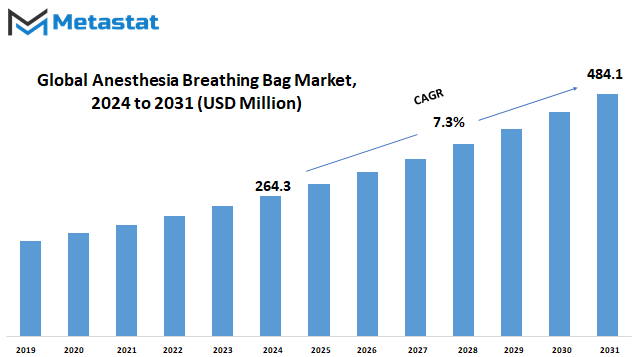
GROWTH FACTORS
The global market for anesthesia breathing bags is being influenced by various factors that are both driving its growth and posing challenges. One of the primary drivers of this market is the increasing demand from downstream sectors. As medical procedures and surgeries become more prevalent worldwide, the need for anesthesia equipment, including breathing bags, is also on the rise. This growing demand is pushing the market forward, as healthcare facilities and professionals seek reliable and efficient equipment to meet patient needs.
Another factor contributing to the growth of the anesthesia breathing bag market is the reduction in costs associated with manufacturing and procurement. Advancements in technology and manufacturing processes have enabled companies to produce these bags more efficiently and at a lower cost. This reduction in cost makes anesthesia breathing bags more accessible to healthcare providers, ultimately driving market growth.
However, despite the positive growth drivers, there are also restraints that need to be considered. One such restraint is government policy and regulation. Regulatory bodies in various countries impose standards and guidelines on medical equipment, including anesthesia breathing bags, to ensure patient safety and product quality. Compliance with these regulations can be challenging for manufacturers and may hinder market growth.
Moreover, technological changes also play a significant role in shaping the anesthesia breathing bag market. Advancements in materials, design, and functionality enhance the performance and safety of these bags, driving demand among healthcare professionals. However, keeping up with rapid technological changes can be a challenge for both manufacturers and end-users, especially in terms of training and investment in new equipment.
Despite these challenges, there are opportunities for growth in the anesthesia breathing bag market. One such opportunity lies in the expanding healthcare industry globally. As populations grow and age, the demand for healthcare services and medical equipment increases. This presents a vast market for anesthesia breathing bags, especially in emerging economies where healthcare infrastructure is rapidly developing.
The anesthesia breathing bag market is driven by factors such as increasing demand from downstream sectors and the reduction in manufacturing costs. However, challenges such as government policy and technological changes need to be navigated. Nevertheless, opportunities for growth abound, particularly in the expanding healthcare industry worldwide. As the market continues to evolve, stakeholders must adapt to seize these opportunities and address the challenges effectively.
MARKET SEGMENTATION
By Bag Size
The Global Anesthesia Breathing Bag market is categorized based on bag size, which includes 3L, 2L, 1L, and others. This segmentation is crucial for understanding the diverse needs and preferences of consumers in the medical field. By dividing the market into different bag sizes, manufacturers can cater to a wider range of healthcare settings and patient requirements.
The 3L, 2L, and 1L bags serve specific purposes and are used in various medical procedures. Each bag size has its advantages and is designed to meet the demands of different anesthesia delivery systems. For instance, larger bags like the 3L are commonly utilized in procedures requiring higher tidal volumes or prolonged ventilation. On the other hand, smaller bags like the 1L are preferred for pediatric patients or scenarios where precise control over ventilation is necessary.
The segmentation into Others further highlights the flexibility and adaptability of anesthesia breathing bags. This category may include bags with unconventional sizes or specialized designs tailored to unique clinical needs. Such bags might be utilized in specialized procedures or niche medical settings where standard sizes may not suffice.
Understanding the market segmentation by bag size enables stakeholders to make informed decisions regarding product development, marketing strategies, and distribution channels. Manufacturers can tailor their offerings to better align with the specific requirements of healthcare facilities and practitioners. This targeted approach enhances customer satisfaction and strengthens the competitive position of companies in the anesthesia breathing bag market.
Moreover, segmentation facilitates research and analysis within the industry. By examining sales data, trends, and consumer preferences across different bag sizes, analysts can derive valuable insights into market dynamics and demand patterns. This information is instrumental in forecasting future market trends, identifying growth opportunities, and mitigating risks.
Additionally, segmentation fosters innovation in product design and technology. Manufacturers can focus their efforts on enhancing the performance, durability, and user friendliness of anesthesia breathing bags across various size categories. This continuous improvement drives product differentiation and fosters a culture of innovation within the industry.
The segmentation of the Global Anesthesia Breathing Bag market by bag size plays a pivotal role in meeting the diverse needs of healthcare providers and patients. It facilitates targeted marketing strategies, enables better decision-making, and drives innovation within the industry. By understanding the distinct requirements associated with different bag sizes, stakeholders can optimize their offerings and stay ahead in this dynamic and vital sector of the medical field.
By Product Type
The global market for Anesthesia Breathing Bags can be categorized into two main types: Disposable Bags and Reusable Bags. In the year 2023, the Disposable Bags segment recorded a total market value of 172.5 million USD, while the Reusable Bags segment amounted to 68.7 million USD.
The distinction between Disposable Bags and Reusable Bags lies in their intended use and longevity. Disposable Bags are designed for single-use applications, typically made from materials that allow for safe disposal after each use. On the other hand, Reusable Bags are constructed from durable materials that withstand multiple uses, making them suitable for sterilization and repeated utilization.
Disposable Bags offer convenience and hygiene, particularly in healthcare settings where cross-contamination prevention is paramount. These bags are often preferred for their ease of disposal, eliminating the need for cleaning and sterilization processes between uses. Healthcare facilities, such as hospitals and clinics, commonly opt for Disposable Bags to maintain a sterile environment and streamline workflow.
In contrast, Reusable Bags provide a sustainable and cost-effective alternative for healthcare providers. While they may require initial investment in sterilization equipment and processes, Reusable Bags offer long-term savings by minimizing the need for frequent replacements. Additionally, their eco-friendly nature appeals to institutions seeking to reduce waste and environmental impact.
The global market for Anesthesia Breathing Bags encompasses both Disposable and Reusable variants, each catering to distinct user needs and preferences. Despite their differences, both segments play integral roles in ensuring safe and effective anesthesia delivery in healthcare settings, driving continued innovation and market growth.
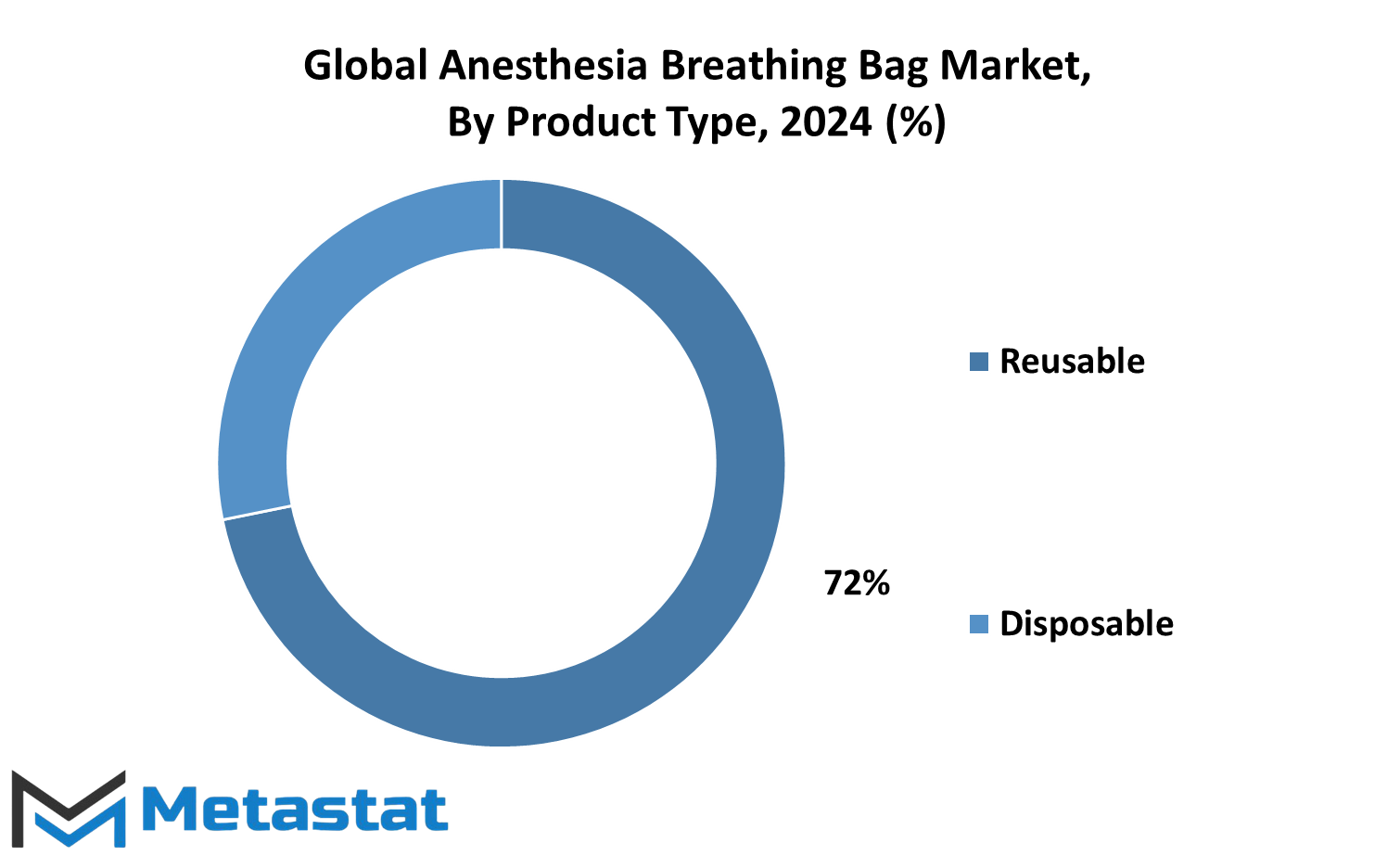
By Raw Material
The Global Anesthesia Breathing Bag market is categorized based on bag size, which includes 3L, 2L, 1L, and others. This segmentation is crucial for understanding the diverse needs and preferences of consumers in the medical field. By dividing the market into different bag sizes, manufacturers can cater to a wider range of healthcare settings and patient requirements.
The 3L, 2L, and 1L bags serve specific purposes and are used in various medical procedures. Each bag size has its advantages and is designed to meet the demands of different anesthesia delivery systems. For instance, larger bags like the 3L are commonly utilized in procedures requiring higher tidal volumes or prolonged ventilation. On the other hand, smaller bags like the 1L are preferred for pediatric patients or scenarios where precise control over ventilation is necessary.
The segmentation into Others further highlights the flexibility and adaptability of anesthesia breathing bags. This category may include bags with unconventional sizes or specialized designs tailored to unique clinical needs. Such bags might be utilized in specialized procedures or niche medical settings where standard sizes may not suffice.
Understanding the market segmentation by bag size enables stakeholders to make informed decisions regarding product development, marketing strategies, and distribution channels. Manufacturers can tailor their offerings to better align with the specific requirements of healthcare facilities and practitioners. This targeted approach enhances customer satisfaction and strengthens the competitive position of companies in the anesthesia breathing bag market.
Moreover, segmentation facilitates research and analysis within the industry. By examining sales data, trends, and consumer preferences across different bag sizes, analysts can derive valuable insights into market dynamics and demand patterns. This information is instrumental in forecasting future market trends, identifying growth opportunities, and mitigating risks.
Additionally, segmentation fosters innovation in product design and technology. Manufacturers can focus their efforts on enhancing the performance, durability, and user friendliness of anesthesia breathing bags across various size categories. This continuous improvement drives product differentiation and fosters a culture of innovation within the industry.
The segmentation of the Global Anesthesia Breathing Bag market by bag size plays a pivotal role in meeting the diverse needs of healthcare providers and patients. It facilitates targeted marketing strategies, enables better decision-making, and drives innovation within the industry. By understanding the distinct requirements associated with different bag sizes, stakeholders can optimize their offerings and stay ahead in this dynamic and vital sector of the medical field.
By End User
The global market for anesthesia breathing bags is categorized by end-users into hospitals, ambulances, and other medical facilities. These bags play a crucial role in delivering anesthesia to patients during surgeries and medical procedures. They ensure a steady flow of gases to the patient's lungs, maintaining the required level of anesthesia throughout the procedure.
Hospitals, being the primary centers for medical care, are the largest consumers of anesthesia breathing bags. These bags are essential equipment in operating rooms, where various surgeries are performed daily. Surgeons and anesthesiologists rely on these bags to administer the right amount of anesthesia to patients, ensuring their comfort and safety during procedures.
Ambulances also utilize anesthesia breathing bags to provide emergency medical care while transporting patients to hospitals. In critical situations, such as accidents or medical emergencies, paramedics need to stabilize patients and manage their pain. Anesthesia breathing bags enable them to administer anesthesia quickly and effectively, ensuring the patient's stability during transit.
Besides hospitals and ambulances, other medical facilities such as clinics and outpatient centers also use anesthesia breathing bags. While they may not have the same volume of usage as hospitals, these facilities still require anesthesia equipment to perform minor surgeries and procedures. Anesthesia breathing bags provide them with the necessary tools to deliver anesthesia safely and efficiently to their patients.
The demand for anesthesia breathing bags is influenced by various factors, including advancements in medical technology, the prevalence of surgical procedures, and healthcare infrastructure development. As medical practices evolve and improve, there is a growing need for high-quality anesthesia equipment to ensure patient safety and comfort during procedures.
Manufacturers in the anesthesia breathing bag market strive to meet the diverse needs of end-users by offering a range of products with different features and specifications. They focus on innovation to develop bags that are lightweight, durable, and easy to use, thereby enhancing the efficiency of medical procedures.
Furthermore, regulatory standards and guidelines play a crucial role in shaping the anesthesia breathing bag market. Manufacturers must comply with strict regulations to ensure the safety and effectiveness of their products. This includes rigorous testing and quality control measures to minimize the risk of complications during anesthesia administration.
The global anesthesia breathing bag market serves hospitals, ambulances, and other medical facilities, providing essential equipment for administering anesthesia during surgeries and medical procedures. As medical practices advance and healthcare standards evolve, the demand for high-quality anesthesia equipment continues to grow, driving innovation and development in the market.
REGIONAL ANALYSIS
The global Anesthesia Breathing Bag market is segmented based on geographical regions into North America, Europe, Asia-Pacific, and others. Each region presents distinct characteristics and factors influencing the market dynamics.
North America, comprising the United States and Canada, holds a significant share in the Anesthesia Breathing Bag market. This can be attributed to the well-established healthcare infrastructure and high adoption rates of advanced medical technologies in this region. Additionally, the presence of key market players and ongoing technological advancements contribute to the growth of the market in North America.
In Europe, countries like Germany, the United Kingdom, and France play a vital role in the Anesthesia Breathing Bag market. The region benefits from a robust healthcare system and extensive investments in research and development activities. Moreover, favorable government initiatives and increasing awareness regarding patient safety and comfort drive the demand for anesthesia breathing bags in Europe.
The Asia-Pacific region, encompassing countries such as China, Japan, and India, is witnessing rapid growth in the Anesthesia Breathing Bag market. Factors such as the rising prevalence of chronic diseases, expanding healthcare infrastructure, and growing healthcare expenditure contribute to market growth in this region. Furthermore, increasing government initiatives to improve healthcare facilities and rising disposable incomes of the population propel the demand for anesthesia breathing bags in Asia-Pacific.
Other regions, including Latin America, the Middle East, and Africa, also contribute to the global Anesthesia Breathing Bag market. Although these regions have comparatively smaller market shares, they offer significant growth opportunities due to the increasing focus on enhancing healthcare services and infrastructure development.
The global Anesthesia Breathing Bag market exhibits regional variations influenced by factors such as healthcare infrastructure, technological advancements, government policies, and socioeconomic factors. While North America and Europe dominate the market due to their well-established healthcare systems and high adoption rates of advanced medical technologies, the Asia-Pacific region presents substantial growth opportunities driven by factors like increasing healthcare expenditure and expanding healthcare infrastructure. Overall, the regional analysis provides valuable insights into the market dynamics, helping stakeholders make informed decisions and devise effective strategies to capitalize on emerging opportunities and overcome challenges in the Anesthesia Breathing Bag market.
COMPETITIVE PLAYERS
The Anesthesia Breathing Bag industry is populated by a variety of companies vying for market share and prominence. Among the prominent players in this sphere are 3M, Ambu, Dragerwerk, Nolato, Teleflex, BD, Arm Strong Medical, Flexicare Medical, Bomimed, Medline Industries, and MJ Patterson. These companies are at the forefront of supplying anesthesia breathing bags, essential equipment in medical settings for administering anesthesia to patients undergoing surgeries or medical procedures.
3M is a well-known name in the medical industry, offering a range of products including anesthesia breathing bags. Similarly, Ambu is recognized for its contributions to the medical field, particularly in the realm of anesthesia equipment. Dragerwerk, Nolato, and Teleflex are also notable contenders in this market, each bringing their own unique offerings and expertise to the table.
BD, another major player, is renowned for its innovative medical solutions, and its presence in the anesthesia breathing bag market underscores its commitment to providing high-quality equipment for medical professionals. Arm Strong Medical, Flexicare Medical, and Bomimed are also significant contributors, catering to the diverse needs of healthcare facilities worldwide.
Medline Industries and MJ Patterson round out the list of key players in the anesthesia breathing bag market. With their extensive product lines and distribution networks, they play crucial roles in ensuring that healthcare providers have access to reliable and efficient anesthesia equipment.
Competition among these players is fierce, driving continuous innovation and improvements in product quality and performance. Each company strives to differentiate itself through various means, whether through technological advancements, cost-effectiveness, or superior customer service. This competition benefits healthcare providers and patients alike, as it leads to a wider selection of high-quality anesthesia breathing bags and encourages ongoing advancements in medical technology.
Moreover, the competitive landscape of the anesthesia breathing bag market extends beyond just the key players mentioned here. Numerous other companies, both large and small, are actively involved in manufacturing and supplying these essential medical devices. This diversity within the market ensures that healthcare facilities have access to a wide range of options to suit their specific needs and preferences.
The Anesthesia Breathing Bag market is populated by a diverse array of competitive players, each contributing to the ongoing advancement and innovation in medical technology. From industry giants like 3M and BD to smaller yet impactful companies like Arm Strong Medical and MJ Patterson, these players collectively strive to meet the evolving needs of healthcare providers and patients worldwide.
Anesthesia Breathing Bag Market Key Segments:
By Bag Size
- 3L
- 2L
- 1L
- Others
By Product Type
- Disposable Bags
- Reusable Bags
By Raw Material
- Latex
- Latex Free
By End User
- Hospitals
- Ambulance
- Others
Key Global Anesthesia Breathing Bag Industry Players
- 3M
- Ambu
- Dragerwerk
- Nolato
- Teleflex
- BD
- Arm Strong Medical
- Flexicare Medical
- Bomimed
- Medline Industries
- MJ Patterson
WHAT REPORT PROVIDES
- Full in-depth analysis of the parent Industry
- Important changes in market and its dynamics
- Segmentation details of the market
- Former, on-going, and projected market analysis in terms of volume and value
- Assessment of niche industry developments
- Market share analysis
- Key strategies of major players
- Emerging segments and regional growth potential



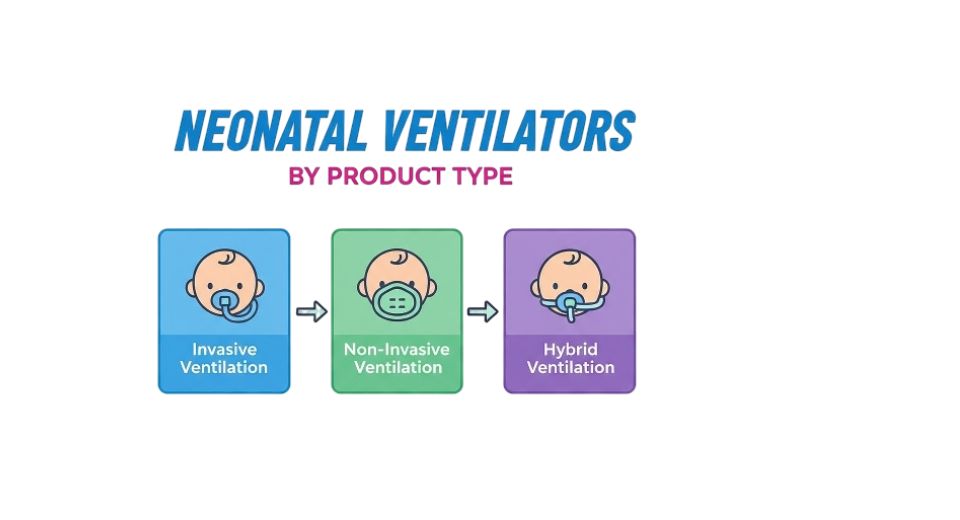
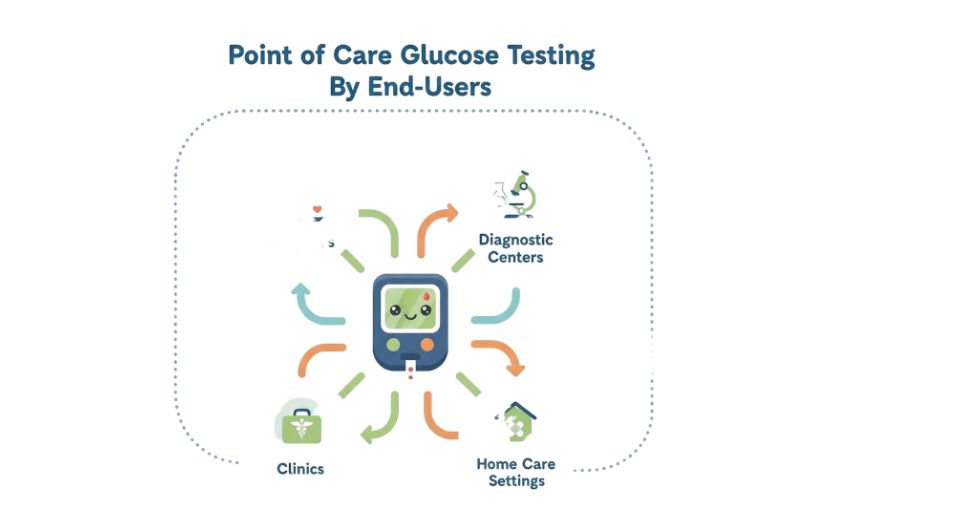

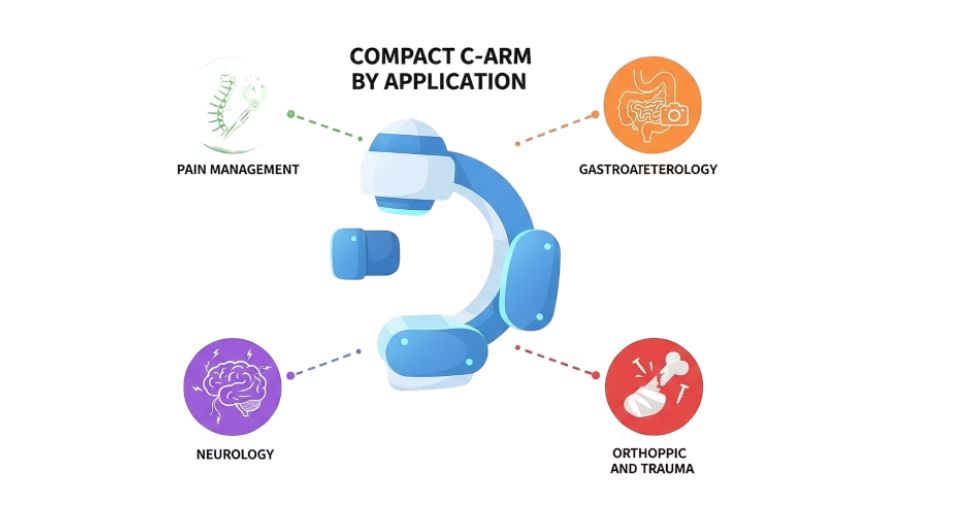

 US: +1 3023308252
US: +1 3023308252






